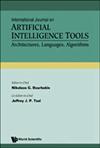乳房肿块分割:跳跃扩展语义网络和机器学习框架
IF 1
4区 计算机科学
Q4 COMPUTER SCIENCE, ARTIFICIAL INTELLIGENCE
International Journal on Artificial Intelligence Tools
Pub Date : 2023-05-01
DOI:10.1142/s0218213023400122
引用次数: 0
摘要
许多医学专家使用计算机辅助诊断(CAD)系统作为检测乳房肿块的第二意见。大量图像的可视化效果不佳,难以精确识别。由于肿块的形状、大小和位置不同,从乳房x光片上分割病变是一项困难的任务。本研究的动机是开发一种方法,可以分割乳房肿块病变从乳房x光图像。目的是在早期阶段对乳房肿块进行更精确的分割。乳腺肿块分割一直是计算机辅助诊断系统的基本要求。在本研究中,肿块异常从乳房x线图像的分割是通过使用跳跃扩张语义分割方法进行的。该研究使用语义卷积神经网络(CNN)使用类权重和扩张因子。利用类权重克服了肿瘤和背景类的类不平衡对平均交联(Intersection over Union, MIOU)和加权iou (weighted-IOU, WIOU)的影响。其次,扩张卷积放大了感受野的暴露,丰富了卷积运算的上下文注意性。使用了两个公开的乳腺x线摄影数据集和CBIS-DDSM。INbreast的跳过扩展语义CNN的WIOU为98.51%,CBIS-DDSM的WIOU为94.82%。本文章由计算机程序翻译,如有差异,请以英文原文为准。
Breast Masses Segmentation: A Framework of Skip Dilated Semantic Network and Machine Learning
Many medical specialists used Computer Aided Diagnostic (CAD) systems as a second opinion to detect breast masses. The poor visualization of mass images makes it difficult to identify precisely. To segment the lesions from the mammograms is a difficult task due to different shapes, sizes, and locations of the masses. The motivation of this study is to develop a method that can segment breast mass lesions from mammogram images. The objective is to perform the segmentation of the breast mass mammogram images more precisely at an early stage. Breast mass segmentation is always a basic requirement in computer-aided diagnosis systems. In this study segmentation of the masses abnormalities from the mammogram images is performed by using the Skipping Dilated semantic segmentation approach. The study uses class weights and Dilation factor using semantic Convolutional Neural Network (CNN). It overcomes the class misbalance in tumors and background class, that affect the mean Intersection over Union (MIOU), and weighted-IOU (WIOU) by using class weights. Secondly, dilation convolution magnifies the receptive field exposure that enriches the convolutional operation with context attentiveness. Two public datasets of mammography INbreast and CBIS-DDSM are used. The WIOU of Skipping Dilated Semantic CNN for INbreast is 98.51% and CBIS-DDSM is 94.82% achieved.
求助全文
通过发布文献求助,成功后即可免费获取论文全文。
去求助
来源期刊

International Journal on Artificial Intelligence Tools
工程技术-计算机:跨学科应用
CiteScore
2.10
自引率
9.10%
发文量
66
审稿时长
8.5 months
期刊介绍:
The International Journal on Artificial Intelligence Tools (IJAIT) provides an interdisciplinary forum in which AI scientists and professionals can share their research results and report new advances on AI tools or tools that use AI. Tools refer to architectures, languages or algorithms, which constitute the means connecting theory with applications. So, IJAIT is a medium for promoting general and/or special purpose tools, which are very important for the evolution of science and manipulation of knowledge. IJAIT can also be used as a test ground for new AI tools.
Topics covered by IJAIT include but are not limited to: AI in Bioinformatics, AI for Service Engineering, AI for Software Engineering, AI for Ubiquitous Computing, AI for Web Intelligence Applications, AI Parallel Processing Tools (hardware/software), AI Programming Languages, AI Tools for CAD and VLSI Analysis/Design/Testing, AI Tools for Computer Vision and Speech Understanding, AI Tools for Multimedia, Cognitive Informatics, Data Mining and Machine Learning Tools, Heuristic and AI Planning Strategies and Tools, Image Understanding, Integrated/Hybrid AI Approaches, Intelligent System Architectures, Knowledge-Based/Expert Systems, Knowledge Management and Processing Tools, Knowledge Representation Languages, Natural Language Understanding, Neural Networks for AI, Object-Oriented Programming for AI, Reasoning and Evolution of Knowledge Bases, Self-Healing and Autonomous Systems, and Software Engineering for AI.
 求助内容:
求助内容: 应助结果提醒方式:
应助结果提醒方式:


